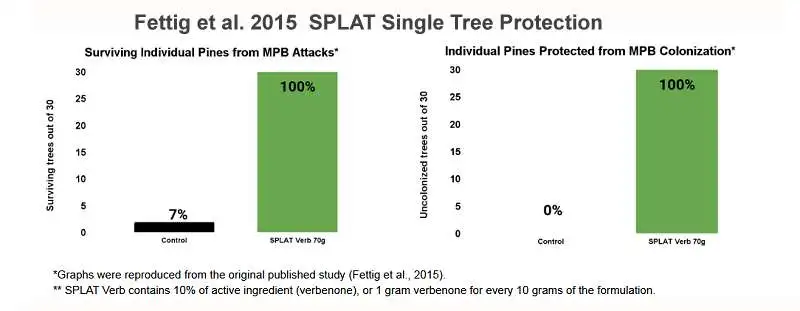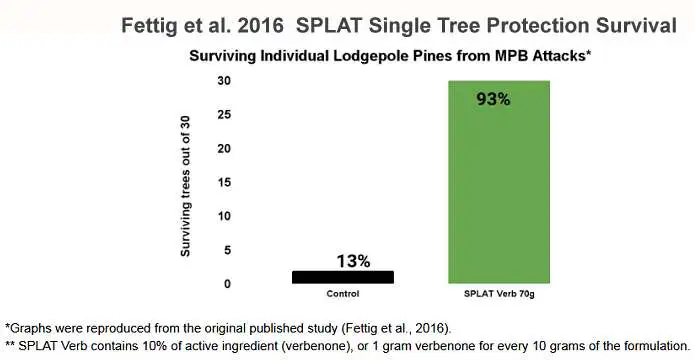Verbenone is a pheromone that tells beetles that a tree is infested, over-populated, and that they should seek a different tree to call home.
Female beetles target and attack damaged, injured, or old trees before releasing a pheromone that attracts male beetles. As the males arrive, they release a "cocktail" of other pheromones, which blows down wind and brings in the hordes.
When the Mountain Pine Beetles sense that their host tree is nearing a state of overpopulation, they produce another pheromone called Verbenone that tells other beetles downwind that they should find a different tree to attack. 
Verbenone Pouches contain synthesized Beetle Verbenone. Once affixed to a tree, these pouches gradually release the pheromone, enveloping the area with a beetle scent that deters incoming beetles, misleading them into perceiving the tree as already infested. Essentially, Verbenone pouches act as a deterrent, signaling to beetles that the tree is occupied.
Mountain Pine Beetles have a limited supply of energy. Therefore, the longer they spend looking for a new host, the higher the mortality from extended flight. Flitting from one tree toward another with a "No Vacancy" sign ultimately exhausts them to death.
Effectiveness of Verbenone
Over the two decades, Verbenone has been shown to be very successful in repelling Mountain Pine Beetles. Most studies have shown that pouches with 7 grams of active verbenone can save up to 97%+ of trees in a properly treated area, even if the trees are fitted with beetle bait.
All studies concluded that treatment with verbenone pouches and SPLAT Verb at roughly 11 meter centers protects trees from attack by the MPB, even when the tested trees included trees with actual beetle bait attached.
- In a 2012-2013 study, 28 out of 30 untreated control trees fell victim to the beetle plague, whereas all SPLAT Verb-treated trees within the same vicinity remained healthy and un-infested a full year after treatment.
- 2016 According to a USDA.gov blog on Feb 3, 2016: Throughout a two-year USDA-funded research project, SPLAT Verb consistently achieved a 100 percent rate of protection when applied to individual lodgepole pines, even when bark beetle infestation rates were shown to be high.
- In addition, these studies showed that SPLAT Verb can produce a protective "halo effect" that repels MPB from the trees up to 11 meters from the one it was directly applied.
- 2012 In an article titled, "Applied Chemical Ecology of the Mountain Pine Beetle" by Robert A. Progar, Nancy Gillette, Christopher J. Fettig, and Kathryn Hrinkevich, Fettig et al. (2012d) began evaluating SPLAT formulated with verbenone ("SPLATVerb") for protecting individual P. contorta (Lodgepole Pine) from mortality attributed to D. ponderosae (MPB) in Wyoming in 2011.
- 2013 Although this research was in the early stages of development, SPLATVerb appeared promising for individual tree protection as 100% tree protection was observed, whereas 93.3% tree mortality occurred in the untreated control. (C.J. Fettig, A. Mafra-Neto, and A.S. Munson, unpubl. data, Jan. 15, 2013).
- In another study on SPLAT Verb efficacy on individual lodgepole pines, there was a zero percent mortality rate on trees treated with SPLAT Verb, compared to a 93% mortality rate in untreated trees. In small stands, treatment with SPLAT Verb proved nearly twice as effective as an alternative verbenone product and reduced tree mortality compared to an untreated control by a factor of 6.
- 2013 to 2015: Results from the Stanislaus National Forest and Yosemite National Park indicated that SPLAT® Verb was efficacious in protecting sugar pines from MPB attack. All SPLAT® Verb treatments were considered extremely efficacious; within the Stanislaus National Forest, less than 5% of trees died as a result of D. ponderosae colonization within the highest dose group and within Yosemite National Park, no trees were colonized or killed by D. ponderosae.
- Fettig et al. 2015 SPLAT Single Tree Protection - Lodgepole Pines: (see graph below) SPLAT Verb demonstrated efficacy in protecting individual lodgepole pines, Pinus contorta, against mountain beetle, Dendroctonus ponderosae (MPB) in a publilshed research trial. All trees were treated with a MPB attractant. An astounding 100% of the 30 trees treated with SPLAT Verb (70g verbenone/tree) survived with no signs of colonization by MPB (despite attractant), whereas only 7% of the 30 untreated trees survived and 0% of the control trees escaped MPB colonization.

- Fettig et al. 2016 SPLAT Single Tree Protection - Lodgepole Pines: (see graph below) SPLAT Verb succeeded in protecting individual lodgepole pines against MPB in another published research trial in 2016. Similarly efficacious results were obtained, with 93% of the MPB-baited trees treated with SPLAT Verb (70g/tree) surviving compared to only 13% of the trees in the control group.

- Fettig et al. 2020 Single Tree Protection - Dose Response - Lodgepole Pines (see graph): In a published research trial, researchers examined the efficacy of different doses of SPLAT Verb (3g, 5g, 7g verbenone/tree) in protecting individual lodgepoles against MPB compared to the 7gm verbenone pouch and against untreated control trees. Each tree received MPB bait.

- Progar et al. 2021 Single Tree Protection - Dose Response - Whitebark Pines (see graph below): A published research trial in 2021 evaluated the efficacy of different dosages of SPLAT Verb (50g, 70g, 140g verbenone/tree) in protecting whitebark pines against MPB, compared to a standard verbenone pouch (14g verbenone) and untreated controls over a two-year period. Each tree also recieved MPB bait. SPLAT Verb was comperable to verbenone pouches in both colonization and mortality by MPB attacks with 100% survival, even with less than half of the active ingredient.
The 14g pouch actually contains twice the active verbenone that the ISCA pouch contains, and it still could not protect better than the 70g verbenone of SPLAT Verb.
7 gm Pouches and SPLAT Verb were nearly comparable in both colonization and mortality by MPB attacks. Pouches insured survival of 97% of the trees and SPLAT insured survival of 100% of the trees to which it was applied.
Southern Pine Beetle (SPB) Effectiveness
- Operational Success of Verbenone Against the Southern Pine Beetle: This study concluded that treatment with Verbenone had a high efficacy rate against SPB when used in a strong program of forest management.
- Results showed that Treatment with (S)-Verbenone at 8 ml per tree in combination with felling all freshly attacked trees worked best to control the onslaught of SPB.
- Spot growth in all five tested infestations treated with this application was completely halted with few or no additional trees being attacked.
- In a Journal of Forestry article entitled, "A Scentsible Approach to Controlling Southern Pine Beetles: Two New Tactics Using Verbenone", results of an early study using systhetic beetle pheromones for controlling southern pine beetle infestations - verbenone - were introduced.
- The techniques, verbenone-only and verbenone-plus-felling, reduce tree loss by disrupting infestation growth. In three years of field tests, the verbenone-only tactic completely suppressed 69 percent of the treated infestations, and the verbenone-plus-felling tactic suppressed 86 percent. The tactics provide much-needed alternatives to current control techniques and will allow suppression of infestations where tree felling is restricted or prohibited.
